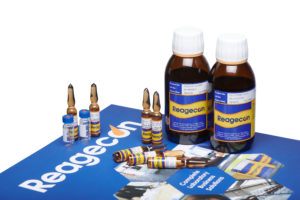Author: John Barron – Managing Director, Reagecon Diagnostics Ltd, Shannon Free Zone, County Clare, Ireland
Abstract
Free fatty acids (also referred to as volatile fatty acids or carboxylic acids) can be difficult to analyse for two reasons. The first, is because of their high polarity, which leads to adsorption problems in columns. The second, is that in the case of unsaturated fatty acids, these may only show small peak differences, which are difficult to distinguish. So, esterification of fatty acids is an important tool for both characterising fats and oils and for quantifying the total fat content of several materials in particular fat content of foods and foodstuffs. It is also an important technique for assessing the quality and purity of biofuels and on an industrial scale, the production of biofuels. Reagecon offers an extensive range of Fatty Acid Methyl Ester & Fatty Acid Ethyl Ester Standards (FAME and FAEE Standards).
Introduction
Free fatty acids (also referred to as volatile fatty acids or carboxylic acids), in short carbon chains, that are volatile, are typically measured in free form as opposed to Fatty Acid Methyl Esters (FAME’s) using Gas Chromatography (GC). Analysis in free form typically confers the advantage of having easier and faster sample preparation and avoids the formation of derivatisation artefacts. However, free fatty acids may be difficult to analyse because these highly polar compounds tend to form hydrogen bonds causing column adsorption problems or in the case of unsaturated fatty acids the slight difference between different compounds may be difficult to distinguish without the neutralisation step involved in esterification.
Context and Processes
The esterification of fatty acids is an important tool for both characterising fats and oils and for determining the total fat content in foods and foodstuffs. It is also an important technique for assessing the quality and purity of biofuels. Fats are extracted using a non-polar solvent, saponised to acids and analysed by gas chromatography (GC). GC is an important technique for fats and oils analysis because accurate results can be obtained for complex as well as simple sample matrices. Several compendium from organisations such as the Association of Official Agriculture Chemists (AOAC), American Oil Chemists Society (AOCS) and the European Pharmacopoeia (EP) contain derivatisation procedures. FAME’s may be produced from vegetable oils, animal fats or waste cooking oils by transesterification. In this process a glyceride reacts with an alcohol in the presence of a catalyst forming a mixture of fatty acid esters and an alcohol thus producing biodiesel. Using triglycerides as the fat source, results in the production of glycerol. Rapeseed, sunflower, soybean and palm oils are the most common raw materials used for the production of biodiesel. Using methanol in the transesterification process has the advantage that the resulting glycerol can be separated simultaneously during the transesterification process. When using ethanol, the ethanol needs to be free of water and the oil needs to have a low water content as well, to achieve an easy glycerol separation. Where ethanol is used it is fatty acid ethyl esters (FAEE’s) that are produced. The end products of the transesterification process are raw biodiesel and raw glycerol. After a cleaning step biodiesel is produced. The purified glycerol can be used in the food and cosmetic industries as well as in the electrochemical industry and as a substrate for anaerobic digestion.
Reagecon FAME and FAEE Standards
Reagecon’s extensive range of products include unsaturated methyl standards, saturated methyl ester standards and fatty acid ethyl standards. The products are available in various matrices in the case of ready to use standards, but are also available in neat (powder) format. The products can be used for calibration of chromatographic instruments (including internal calibration), quality control, method validation and instrument qualification.

